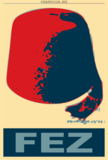But few faiths are as ritualistic and dogmatic as the Catholic Church. From the silliness of the eucharist (which always bothered Luther) to dressing up their pontiff in a variety of silly hats (so silly that starting with John Paul I and continued by his successors JP II and now Benedict XVI they have not put the silly Papal Tiara on their head [assisted I might add by a symbolic gesture of Paul VI years earlier -- you can see it on Pope Piux XII on a recent post, but if you are even too lazy to scroll down you can go here). Few can match the ritual and silliness of the Vatican.
And, of course, there is the ascribed "infallibility" of the Pope dogma, which is just silly on its face. I'm sure that people can ascribe the "infallibility" starting when the person becomes Pope, but that doesn't really work either. As this Pope clearly shows:
Stephen VI (VII) (a complicated story, we'll get to that some other time) 896-7:

There have been some wacky Popes (and let's not even get into the legend of Pope Joan) but Stephen VI (VII) is definitely up there.
Stephen was a Roman, and the son of a priest (so it gets good from the beginning). He had been consecrated Bishop of Anagni, possibly against his will, by Pope Formosus, and became pope about May, 896. Whether induced by evil passion or perhaps, more probably, compelled by the Emperor Lambert of Spoleto and his mother Ageltruda (and undoubtedly influenced by the Farmer and the rest of the Corrente Sect), he caused the body of Formosus to be exhumed, and in January, 897, to be placed before an unwilling synod of the Roman clergy, dressed up in papal garments.
This was called the "Cadaver Synod" and is the subject of this LOVELY PAINTING...

The true motivation for the Cadaver Synod was political. Pope Formosus was initially forced to crown Lambert, one of the sons of the Duke of Spoleto, as co-ruler of the Holy Roman Empire. But Formosus's loyalty was not to the ruling family of Spoleto, but rather to the East Frankish illegitimate descendants of Charlemagne. After the Franks invaded Italy in 896, Formosus withdrew his support of the Spoletans and crowned Arnulf of Carinthia as Holy Roman Emperor. Formosus was succeeded by Pope Boniface VI, who died after only two weeks as pontiff. When Stephen, a partisan of the Spoletans, became pope, Lambert induced him to convene the Cadaver Synod as a way of undermining Arnulf's claim to the throne. Since Formosus had consecrated Stephen as bishop of Anagni, the annulment of Formosus's acts also freed Stephen of the charge that he had himself illegally become bishop of Rome while serving as the head of a different diocese.
A deacon was appointed to answer for the deceased pontiff, who was condemned for performing the functions of a bishop when he had been deposed and for passing from the See of Porto to that of Rome (it was thought that if your were the Bishop of once place, you could not become the Bishop of Rome simultaneously).
The corpse was then stripped of its sacred vestments, deprived of two fingers of its right hand, clad in the garb of a layman, and ultimately thrown into the Tiber. Fortunately it was not granted to Stephen to have time to do much else besides this atrocious deed. Stephen was not Pope very long
The macabre spectacle turned public opinion in Rome against Stephen. Rumors circulated that Formosus's body, after washing up on the banks of the Tiber, had begun to perform miracles. A public uprising led to Stephen being deposed and imprisoned. While in prison, in July or August of 897, he died by strangulation. Stephen forced several of those who had been ordained by Formosus to resign their offices and he granted a few privileges to churches.
 Rising Hegemon
Rising Hegemon
No comments:
Post a Comment